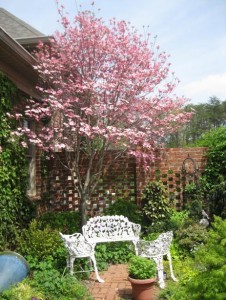 When choosing a tree for a patio you should consider several factors; function, size, tree needs, and upkeep. Shade is probably the most common reason people want a tree in their patio but there are other reasons, such as providing fruit or flowers. Perhaps you want to attract birds, want to provide winter interest like evergreen foliage or a beautiful silhouette, or block out the view of the neighbor’s house. Whatever your purpose, define it in your mind before going on to the next step in the selection process.
When choosing a tree for a patio you should consider several factors; function, size, tree needs, and upkeep. Shade is probably the most common reason people want a tree in their patio but there are other reasons, such as providing fruit or flowers. Perhaps you want to attract birds, want to provide winter interest like evergreen foliage or a beautiful silhouette, or block out the view of the neighbor’s house. Whatever your purpose, define it in your mind before going on to the next step in the selection process.
Once you have decided on the function of the patio tree consider size. A patio may be small or large and there is a tree for both. The tree should be in scale with the patio and you may have to wait for several years until the tree grows to maturity. Take into consideration both the mature size and the rate of growth and ask yourself how long are you willing to wait for a sapling to develop a full canopy that will provide shade? Or produce flowers and fruit? Or block out the neighbor’s house?
Trees need light, water, and a certain soil. Your patio has to provide these basic needs or the patio tree will not grow well. Get a soil sample, find out your hardiness zone, and determine the water constraints and how you can supplement if necessary. As you choose your tree make sure you can meet its need.
Trees, like other plants, require care. Consider how much time you are willing to spend taking care of the patio tree. Some trees create a litter problem when they drop their leaves, flowers, seedpods, or fruit. These droppings have to be cleaned up and they may leave stains on the hardscape or furniture. Other trees have roots that can ruin the paving of a patio or invade nearby beds. Insects and disease can be a problem and require spraying or other special attention. People may have allergies to the pollen of the trees. All of these considerations should enter in the decision of selecting the right patio tree.
Here are five trees that are generally considered good for the patio. They each offer something different in terms of function but all are relatively small and require little care.
 Japanese maple (Acer palmatum)
Japanese maple (Acer palmatum)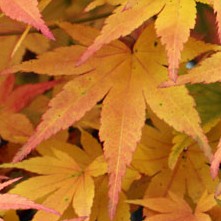 This deciduous tree (or shrub) comes in many forms and offer a big variety in leaf shape and color. Many have beautiful fall color and stems that are attractive in winter. They tend to be multi-stemmed and may be erect or weeping. The plants with green undissected leaves tend to be faster growing and less demanding than other varieties. It can be grown in a container.
This deciduous tree (or shrub) comes in many forms and offer a big variety in leaf shape and color. Many have beautiful fall color and stems that are attractive in winter. They tend to be multi-stemmed and may be erect or weeping. The plants with green undissected leaves tend to be faster growing and less demanding than other varieties. It can be grown in a container.
-
Outstanding Characteristic: Foliage color and texture
Height: Up to 30′ depending on cultivar
Site: Partial shade; evenly moist, well-drained soil
Growth Rate: Slow to moderate
Hardiness: Zones 5-8
 Buddhist Pine (Podocarpus macrophyllus)
Buddhist Pine (Podocarpus macrophyllus)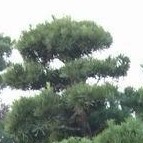 Not a true pine, this evergreen tree is grown for its attractive foliage and interesting form. It has bright green leaves and an upright narrow form. It can be espaliered or pruned into topiary and grows well in a large container. P. macrophyllus var. maki is a slow growing small variety.
Not a true pine, this evergreen tree is grown for its attractive foliage and interesting form. It has bright green leaves and an upright narrow form. It can be espaliered or pruned into topiary and grows well in a large container. P. macrophyllus var. maki is a slow growing small variety.
-
Outstanding Characteristic: Evergreen foliage
Height: 15-40′
Site: Full sun to part shade; evenly moist, well-drained, slightly acidic
Growth Rate: Slow-medium
Hardiness: Zones 7-9
 Crepe Myrtle (Lagerstroemia hybrids)
Crepe Myrtle (Lagerstroemia hybrids)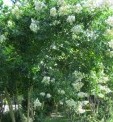 This deciduous tree is attractive in all seasons with its abundance of flowers in summer, great fall coloration, and exfoliating bark for winter and early spring interest. Plants begin blooming when young. Hybrids have the advantage over other crepe myrtles of being resistant to mildew. Many are multi-stemed.
This deciduous tree is attractive in all seasons with its abundance of flowers in summer, great fall coloration, and exfoliating bark for winter and early spring interest. Plants begin blooming when young. Hybrids have the advantage over other crepe myrtles of being resistant to mildew. Many are multi-stemed.
-
Outstanding Characteristic: Flowers, fall coloration, exfoliating bark
Height: 9-20′ depending on the cultivar
Site: Full sun; moist, well-drained soil
Growth Rate: Rapid
Hardiness: Zones 7-10
 Amur Maple (Amur ginnala)
Amur Maple (Amur ginnala)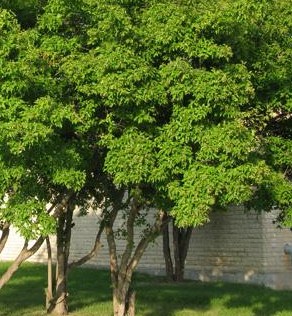 At twenty feet high this deciduous tree is multi-stemmed and has a broad, rounded outline that provides dense shade. Its fall coloration is red and several cultivars have been bred for outstanding color. It can be heavily pruned and grows well in containers. Grows best in cool climates.
At twenty feet high this deciduous tree is multi-stemmed and has a broad, rounded outline that provides dense shade. Its fall coloration is red and several cultivars have been bred for outstanding color. It can be heavily pruned and grows well in containers. Grows best in cool climates.
-
Outstanding Characteristic: Canopy, fall coloration
Height: 20-30′
Site: Part sun/shade; moist, well-drained soil
Growth Rate: Medium to rapid
Hardness: Zones 3-8
 Citrus
Citrus Few gardeners have the climate to can grow citrus trees in their patio except in containers but where it is possible it is a wonderful treat. The trees are evergreen so provide year round shade and beauty, and hold on to their fruit for an extended time so can be harvested over many weeks. The foliage is attractive and the flowers have a lovely fragrance. The quality of the fruit is dependent on the amount of heat available through the fruit-developing period and the winter cold. ‘Valencia’ and navel oranges are a favorite. Citrus can be grown in containers.
Few gardeners have the climate to can grow citrus trees in their patio except in containers but where it is possible it is a wonderful treat. The trees are evergreen so provide year round shade and beauty, and hold on to their fruit for an extended time so can be harvested over many weeks. The foliage is attractive and the flowers have a lovely fragrance. The quality of the fruit is dependent on the amount of heat available through the fruit-developing period and the winter cold. ‘Valencia’ and navel oranges are a favorite. Citrus can be grown in containers.
-
Outstanding Characteristic: Fruit
Height: 10-30′ tall depending on type of tree and if grafted
Site: Full sun; medium moist, well-drained soil
Growth Rate: Medium
Hardiness: Zones 8-10 (variable with variety)
